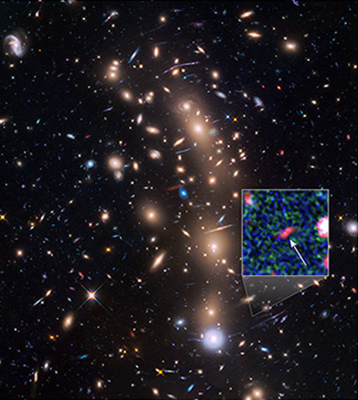Astronomers harnessing the combined power of NASA's Hubble and Spitzer space telescopes have found the faintest object ever seen in the early universe. It existed about 400 million years after the big bang, 13.8 billion years ago.

The team has nicknamed the object Tayna, which means "first-born" in Aymara, a language spoken in the Andes and Altiplano regions of South America.
Though Hubble and Spitzer have detected other galaxies that are record-breakers for distance, this object represents a smaller, fainter class of newly forming galaxies that until now have largely evaded detection. These very dim objects may be more representative of the early universe, and offer new insight on the formation and evolution of the first galaxies.
"Thanks to this detection, the team has been able to study for the first time the properties of extremely faint objects formed not long after the big bang," said lead author Leopoldo Infante, an astronomer at Pontifical Catholic University of Chile (Pontificia Universidad Católica de Chile). The remote object is part of a discovery of 22 young galaxies at ancient times located nearly at the observable horizon of the universe. This research is a substantial increase in the number of known very distant galaxies.
The results are published in the Dec. 3 issue of The Astrophysical Journal.
The new object is comparable in size to the Large Magellanic Cloud (LMC), a diminutive satellite galaxy of our Milky Way. It is rapidly making stars at a rate ten times faster than the LMC. The object might be the growing core of what will likely evolve into a full-sized galaxy.
The small and faint galaxy was only seen thanks to a natural "magnifying glass" in space. As part of its Frontier Fields program, Hubble observed a massive cluster of galaxies, MACS J0416.1-2403, located roughly 4 billion light-years away and weighing as much as a million billion suns. This giant cluster acts as a powerful natural lens by bending and magnifying the light of far-more-distant objects behind it. Like a zoom lens on a camera, the cluster's gravity boosts the light of the distant protogalaxy to make it look 20 times brighter than normal. The phenomenon is called gravitational lensing and was proposed by Albert Einstein as part of his General Theory of Relativity.
For more information about this study and Hubble, visit:
http://hubblesite.org/newscenter/archive/releases/2015/45/
